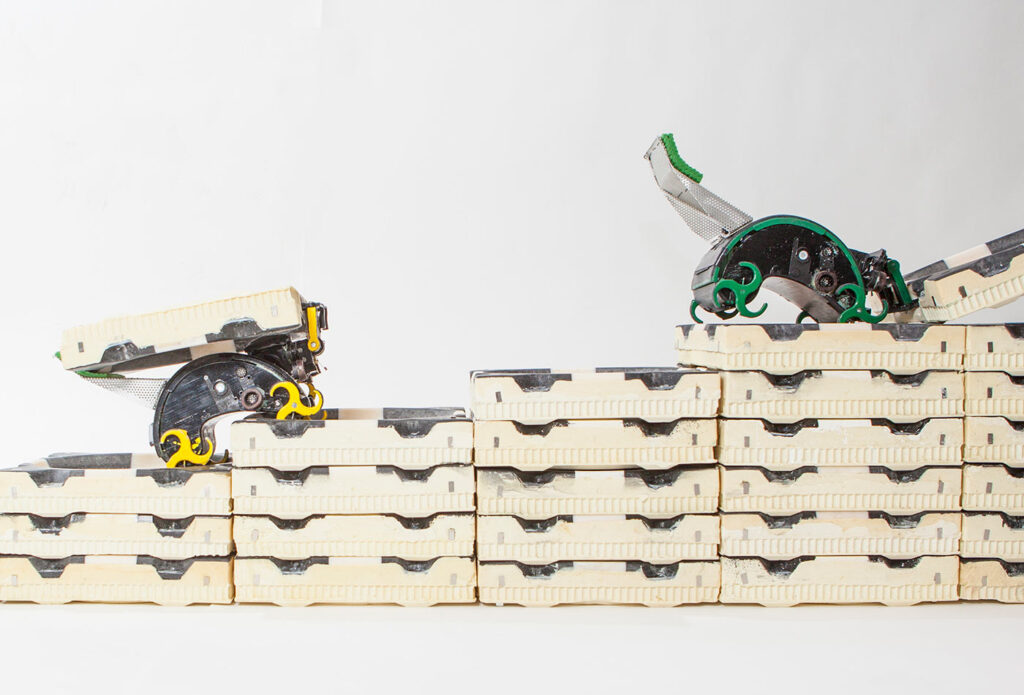A field of robotics called swarm robotics are becoming potential to replace humans and get involved in Construction business, by their irresistible intelligent way of functioning.
Architecture & Constructions had improved a lot over the years, with buildings starting to be smart enough to self-heal, self-cool and even more. Technology maneuvered construction business refreshing its structure from the base. For instance, 3D printing enabled to build ten-houses within 24 hours in China back in 2014, which would be impossible for sure in the conventional way of doing it.
In the kind, a new revolutionary work in robotics – Swarm Robotics – a group of robots intended to perform the task employed, collaboratively and conjointly. The swarm robots, as the name implies are dense number of small robots working for a common task and the interesting fact is that the idea was inspired from termites, which do the same for building their house.
What is Swarm robotics?
Swarm robotics is that branch of robotics that deals with the accomplishment of tasks using multiple robots that are systematized to work as a team coordinately for finishing the task. The swarm robots are small physical robots that are inter-connected and has a collective inter-behavior and interactions with the other robots and with the environment through sensors, fore-mostly to accomplish the task.
The swarm-bots’ behavior itself is actually influenced by a part of artificial intelligence called swarm intelligence. Swarm intelligence is the study of collective behavior of decentralized, self-organized systems, natural or artificial.
What Swarm-robots do?
The inter-linked swarm-bots, when given the tasks, interact with the other robots by means of communication modes, like Wi-fi, radio frequency and infrared. Communication is the key element between the robots that build a system of constant feedback.
Swarm-bots don’t have any centralized conduct on the robots, instead each of the robots involved, work through the task conjointly and if any robot malfunctions, the others do carry the task as usual. The bots should be self-controlled and efficiently use sensors for manipulating and sensing their shared environment.
Swarm robots should be as simple and efficient to deal with the cost and performance factor. Robots must confront the tasks inserted optimally, thus improving the scalability and be miniaturized for convenient functioning of the robots and for cost-reduction.
In Construction technology
Swarm robotics, its features and anatomy have a great impact in constructions. Give the swarm-bots, the final design, prescribe their rules for operating and set them to the task. The swarm-bots pick the bricks up, fix it in the slotted space until the wall is built to its final design, thereby working as a team while maneuvering around the other swarm-bots. Here, as they don’t have any main control, a central-pointing failure is prevented, raising the reliability and redundancy of functioning. As said earlier, if any bot malfunctions, others do carry on.
This makes them to be employed in construction works at remote areas, where humans’ work are under risk like mountainous regions. If at all, failure happens to a bot, its just a piece of money. Also, at the vent of assigning the tasks to the bots, the work is carried out unremittingly till the feat of completing, as quick as possible.
On account of all these possessions, swarm-bots are widely employed in the construction realm, viz., in the construction of space stations, deep underwater gas pipelines, or laying oxygen pipelines in Moon, which NASA is planning for. It could also be useful in the disaster-rescue missions and for surveillance.
Related Posts
Significance from nature
Like the invention of SONAR was inspired from dolphins’ way of transmitting sound, swarm robotics was made resembling termites. Despite its diminutive size, the termite is one of nature’s most ingenious builders and, in large numbers, is capable of creating amazingly complex mud structures. How the termites do this is interesting as they do not follow the commands of a central “architect” termite, but rather the rules of behavior are imprinted in its DNA.
There’s actually a field called “Biomimicry” exists that dwells upon technology & innovations mimicked from nature’s act (animals, birds or plants).
This shows up that nature is the best teacher, ever! However, claps to the Harvard’s Self-organizing Systems Research Group for laying the research on this bots.
Future of Swarm-robots
Safety issues and jobs at non-viable human sites are the few to mention that brings the need of swarm robotics in constructions. Construction industries has seen profuse accidents over years & swarm robots potentially might replace construction works in unsafe remote areas. And indeed, they are claimed to be cost-efficient than the excavators, tower cranes and other hi-tech construction equipment.
Read also: Robotics – An Overview
To address reinforcements of a levee wall, works at heights but no proper support, and heavy continuous works, swarm-robots are emerging as a befitting technology. Further, swarm intelligence accompanying these robots would be valued at $447.2 million industry in 2030 with a 40% growth from 2020, sources say.
As swarm robots expectedly designed to perform in remote areas, their chances of taking over humans’ job are minimal at present, unlike AI chatbots.
Would you let your house to be built by a robot?
(For more such interesting informational, technology and innovation stuffs, keep reading The Inner Detail).
References:

